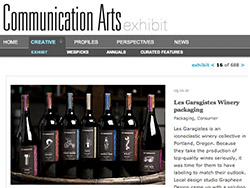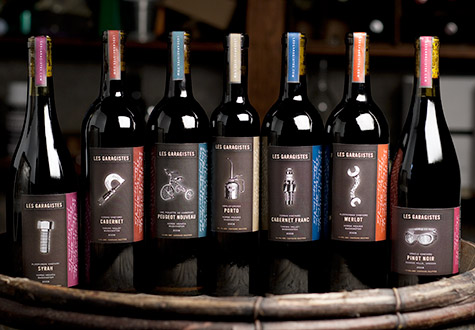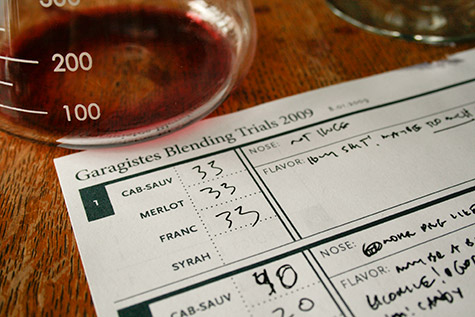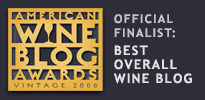Archive for the '2008 Garagistes' Category
We turn up in Communication Arts
 Here’s some amazing news: while I was out of the country, my design firm‘s packaging overhaul for Les Garagistes was featured in Communication Arts! “CA” (as we grizzled veterans call it) is the design industry’s premier journal, so getting showcased in it is both flattering and humbling. Thank you, CA!
Here’s some amazing news: while I was out of the country, my design firm‘s packaging overhaul for Les Garagistes was featured in Communication Arts! “CA” (as we grizzled veterans call it) is the design industry’s premier journal, so getting showcased in it is both flattering and humbling. Thank you, CA!
I think this calls for uncorking one o’ them packages in celebration …
No commentsThis year’s models
 I finally had a chance to shoot our current stable of wine releases, which — holy crap — are kind of numerous. Who snuck into our basement and made all this wine, anyway?
I finally had a chance to shoot our current stable of wine releases, which — holy crap — are kind of numerous. Who snuck into our basement and made all this wine, anyway?
From left to right, ya got yer:
- 2008 Aldercreek Syrah
- 2008 Cowan Cabernet Sauvignon
- 2009 Peugeot Nouveau (Coyote Canyon)
- 2008 Porto (piloted by Aldercreek Merlot)
- 2008 Cowan Cabernet Franc
- 2008 Aldercreek Merlot
- 2008 Oracle Vineyard Pinot Noir
The new label design was driven by a need to capture a little more of the Garagistes’ essential subversiveness, while still presenting a fancy enough front that we can continue to pretend we’re real winemakers. So I dug through some archival clip art to find tools and other gewgaws you might find in a French garage, then tried to pair them with the personality of our various wines.
Some are more successful than others, to be sure. I think the caliper for the Cab Sauv is the shakiest, in part because its essential P shape is a bit of a miscue. Its first home was on the Pinot, actually, but then I fell in love with how racy and devil-may-care the goggles felt on that wine. But calipers do suggest some sense of precision, so I suppose they’re not inappropriate for a Cabernet (though our Cabernet? Well…).
My most brilliant stroke, of course, was using a tricycle for the just-out-of-swaddling-clothes Nouveau, because that gives us a chance to finally break into the child market.
More pics and a frantic disavowal of what I just said after the jump…
1 commentBlending Trials: we go for the decimals
 It was a hot afternoon, but five of us coolly assembled to taste through each of our four main wines — Cabernet Sauvignon, Merlot, Cabernet Franc, and Syrah — to determine what part they’ll play in this year’s Peugeot blend.
It was a hot afternoon, but five of us coolly assembled to taste through each of our four main wines — Cabernet Sauvignon, Merlot, Cabernet Franc, and Syrah — to determine what part they’ll play in this year’s Peugeot blend.
First, to get the lay of the land, we tasted through the wines individually. Frankly, I was a little surprised at how nicely the Cab had evolved — last fall, this one came into the winery like a health care protester, barely ripe and a little unbalanced. But my notes now began, “Wow, big fruit!” Amalgamated notes from the tasters:
Lovely cherry/raspberry nose, but maybe a bit on the hot side. Tart, but alive. Ripe raspberry and blackberry, with a touch of pepper. Elegant, generally round and full throughout, but fading quickly on the finish. Grippy tannins on the finish — good for some, a bit much for others. Cocoa and minerals. Maybe a little monotone. [Mike adds] The first Cab I could have with salmon.
All in all, better than we could have hoped for. Next up was the Merlot…
Read more
Operation Tactical Rack Begins
The early-response team of les Garagistes parachuted in a week or so ago to begin its extraction of our wines from potential bacterial danger. Its thankless mission: to secure one and a half wines, creating a beach head from which rearguard troops could make precise tactical strikes, hounding brett, VA and their terrorist minions back into their caves (pronounced “cah-ves”) and finishing them off for good.
And ladies and gentlemen, here on the aircraft carrier that is our dingy basement, I can unequivocally say, “Mission Accomplished.” Two and a half to go.
The assault began at base camp on the sunny back porch, where we opened the 2008 Rosalie Rosé to war-game its implications. This was the first time I’d tried it since we bottled it a month or so ago, so I was curious to see if its genie was ready to come back out. Jon had reported a slight fizziness when he’d opened one a week or so prior, but if it existed in the one we opened, it was very slight, indeed. The fruit was fresh and clean, and since I’d waited a day too long to drain it from the tank and start it fermenting back in the all, it was full-flavored and a lovely ruby color.
Conclusions drawn, we marched downstairs into battle carrying controversial orders to move some wine to and fro, then back into the vessel from which it came. Luckily, I was not fragged for this seemingly pointless directive. “I’m just following orders from ETS Labs Command,” I explained. My compatriots rolled their eyes, gently suggesting I discontinue the I’m-looking-nobly-into-the-future-from-a-windswept-cliff pose I’d been affecting, and do a lick of work for a change.
We racked the Cabernet Franc out of barrel and variable tank, and back into barrel and carboy. With that variable now free, we were able to move all the Syrah currently spread out across 7 carboys into a single, stainless steel home. Since there’s more Syrah than Franc, this switcheroo earned us 3-4 empty carboys to use as the situation on the ground may dictate in the future.
I was pretty happy with the Franc, actually. The last time we racked it, it was closed and even a bit vegetal in nose and mouth. But now it had regained some of its composure, with nice weight in the mouth and lovely fruit, with no veg I could detect. Perhaps it was finishing malo before? Anyway, something to keep an eye on, since the grapes weren’t super ripe to begin with.
For both wines, we sulfited to 25ppm based on .5 mg/l molecular SO2, so for now, I’m logging those wines as secured. According to the incredibly informative seminar I took at Chemeketa Community College’s sparkling Northwest Viticulture Center just outside of Salem, we’ll want to monitor free SO2 pretty frequently to ensue the wine stays healthy and our enemies gain nary a foothold.
Next up, the other half of the syrah, and all the merlot.
No commentsRosé est arrivée
Earlier tonight, a hardy crew assembled to lay the rosé to rest and give the port a quick racking. The port tasted very lovely but very young, and was surprisingly different across carboys, but the star of the evening was the luscious rosé.
You may recall that this wine was a seignée of the syrah we picked this year — that is, you “bleed” (seignée) the fermenter of juice just after crush, and then ferment that pink juice as a rosé. Unfortunately, I waited a bit too long before drawing blood, so this rosé is actually quite bloody — good for drinking, but it probably took a little something from the syrah left fermenting.
In any case, the rosé started out with a relatively high pH — which is to say, it was very low on acid. That not only meant it had less ability to fight off deadly contagion (like the bacteria that turn wine to vinegar), it tasted “flabby” and even a bit soapy (though ladies, I’m told, like it too). Luckily, it was otherwise clean, so a few days ago, I added a bit of acid to perk the young scalliwag up.
Sure enough, that brought down the pH to around 3.66, which is still pretty high for a white/rose wine, but much healthier. Those assembled for bottling tonight all soberly tasted it, and admired its ample fruit and generous taste. Nevertheless, I was still nervous about that pH, and we all agreed it could take a little more acid without freaking out and seeing spiders.
After a second addition, the pH had dropped to 3.55, much safer microbially speaking (and isn’t that the only way to speak, these days?). Better, we all noticed the difference instantly in the glass: much more forwardly floral, and much more alive in the mouth.
As the wine equalizes and absorbs that late acid addition, the pH will probably creep back up a hair. Nevertheless, after maybe a month’s worth of solitude to recover from bottling, this should be a lovely summer quaffer to lie down in the tall grass and enjoy.
No commentsRacking the ’08 Cab
On Wednesday, Melissa, Whit and I racked the Cabernet Sauvignon, which had been split between a barrel and a variable height tank.
Readers with ESP will remember that in mid-winter, before we were able to get another variable tank, about 3/4-barrel’s worth of Cab had been exposed to a lot of oxygen as it went through malolactic. I’d crossed my fingers that the CO2 produced during malo would offer it some protection, but when Whit, Mike and James racked it late January, they detected some off odors — “compost,” Mike even said. I don’t know about you, but that’s a je ne sais quoi I know I’m always looking for in a fine wine. In any case, they cordoned off the offending wine into the variable tank, keeping the barrel pure.
Happily, I didn’t detect anything like that in the tank as I popped the lid — or as we racked it — so hopefully, what they were smelling/tasting was simply the end of malo. In any case, both barrel and tank tasted fresh and full, though the wine in the tank was much more closed and youthful, as you might expect. Because of that, the vegetal tiny of the Cab (due both to the varietal, but also less ripe fruit than we’d hoped for) was much higher in the tank; in barrel, the oak seems to be intertwining itself with the veg to make it less apparent and the wine correspondingly more pleasant.
All in all, the wine is sound and as I said, it looks lovely. My guess is that unless we can pull back the green pepper in the wine, however, the Cab will have less of a voice in the blend than we might like.
No commentsHarvest update: about a week away
Just got off the phone with one of our growers in Horse Heaven, where the Merlot is coming on strong — in fact, it may be ready by the weekend or early next week.
As of the 18th, block samples ranged from 23.7 – 25.8 brix, .64-.53 TA (acidity), and 3.2 – 3.3 pH. Those are still out of balance, so he’s been putting a little water on the grapes to keep the sugars in check and buy some time while the acidity declines. Given the numbers we typically get with Eastern Washington fruit (much higher pHs than Willamette Valley fruit), I’d love to see us in the 3.6 pH ballpark, with sugars right around 24.5-25.
Sounds like the grower shares that objective, so things are looking good for a lovely Merlot to start harvest off just right. Better get the basement winery remodel done!
(btw, he estimates Syrah as still about 2-3 weeks out)
No comments
